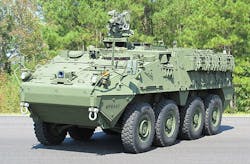While traditional markets for military vehicles such as the U.S. are choosing to upgrade and maintain existing fleets rather than replace aging vehicles, other regions are looking to purchase new units, which provides maintenance, upgrades, and vetronics opportunities, as well as export potential, that will provide a steady source of revenue, analysts say.
Growth, however, will be relatively slow in the short term due to austerity measures in several of the world’s major defense markets, analysts say. Sluggish economic growth in non-austerity-hit regions also has caused some emerging markets such as India to become less attractive in the short term. This is expected to change in the medium term as economic pressures ease.
Economic recovery eventually will reinvigorate defense spending on global military land vehicles in the medium-to-long-term. Spending on military land vehicles particularly will be high in North America, with the U.S. planning major procurements in 2016 and beyond, and, to a lesser degree, in Europe, analysts say.
Related: Oshkosh to build 246 additional military vehicles equipped with SAE electronic databuses
The Chinese and Russian military land vehicle markets, meanwhile, also will be significant contributors to the global market size.
"Some governments, especially those implementing cost-cutting measures, are expected to opt for expeditionary strategies of upstream capacity building and short-term overseas interventions to influence conflicts in the 2013-2022 timeframe," says Richard Hilton, aerospace and defense program manager at Frost & Sullivan.
"As such, they will seek to add a mix of light and airlift-capable vehicles to their inventory while holding on to heavy-vehicle inventories, which they regard as a potent symbol of military power," Hilton says.
Other governments will need to balance the procurement of heavy vehicles to achieve a modern and advanced military status with increased acquisition of light, agile forces to overcome insurgency-type conflicts in difficult environments.
For more information contact Frost & Sullivan online at www.frost.com



